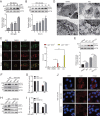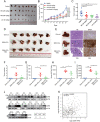Isoginkgetin, a potential CDK6 inhibitor, suppresses SLC2A1/GLUT1 enhancer activity to induce AMPK-ULK1-mediated cytotoxic autophagy in hepatocellular carcinoma
- PMID: 36048765
- PMCID: PMC10012924
- DOI: 10.1080/15548627.2022.2119353
Isoginkgetin, a potential CDK6 inhibitor, suppresses SLC2A1/GLUT1 enhancer activity to induce AMPK-ULK1-mediated cytotoxic autophagy in hepatocellular carcinoma
Abstract
Isoginkgetin (ISO), a natural biflavonoid, exhibited cytotoxic activity against several types of cancer cells. However, its effects on hepatocellular carcinoma (HCC) cells and mechanism remain unclear. Here, we revealed that ISO effectively inhibited HCC cell proliferation and migration in vitro. LC3-II expression and autophagosomes were increased under ISO treatment. In addition, ISO-induced cell death was attenuated by treatment with chloroquine or knockdown of autophagy-related genes (ATG5 or ULK1). ISO significantly suppressed SLC2A1/GLUT1 (solute carrier family 2 member 1) expression and glucose uptake, leading to activation of the AMPK-ULK1 axis in HepG2 cells. Overexpression of SLC2A1/GLUT1 abrogated ISO-induced autophagy. Combining molecular docking with thermal shift analysis, we confirmed that ISO directly bound to the N terminus of CDK6 (cyclin-dependent kinase 6) and promoted its degradation. Overexpression of CDK6 abrogated ISO-induced inhibition of SLC2A1/GLUT1 transcription and induction of autophagy. Furthermore, ISO treatment significantly decreased the H3K27ac, H4K8ac and H3K4me1 levels on the SLC2A1/GLUT1 enhancer in HepG2 cells. Finally, ISO suppressed the hepatocarcinogenesis in the HepG2 xenograft mice and the diethylnitrosamine+carbon tetrachloride (DEN+CCl4)-induced primary HCC mice and we confirmed SLC2A1/GLUT1 and CDK6 as promising oncogenes in HCC by analysis of TCGA data and human HCC tissues. Our results provide a new molecular mechanism by which ISO treatment or CDK6 deletion promotes autophagy; that is, ISO targeting the N terminus of CDK6 for degradation inhibits the expression of SLC2A1/GLUT1 by decreasing the enhancer activity of SLC2A1/GLUT1, resulting in decreased glucose levels and inducing the AMPK-ULK1 pathway.
Keywords: Autophagy; CDK6; SLC2A1/GLUT1; hepatocellular carcinoma; isoginkgetin.
Conflict of interest statement
No potential conflict of interest was reported by the author(s).
Figures







Similar articles
-
Formosanin C induces autophagy-mediated cell death in hepatocellular carcinoma through activating DUSP1/AMPK/ULK1/Beclin1 signaling pathway.Phytomedicine. 2025 Mar;138:156404. doi: 10.1016/j.phymed.2025.156404. Epub 2025 Jan 22. Phytomedicine. 2025. PMID: 39862789
-
The role of the key autophagy kinase ULK1 in hepatocellular carcinoma and its validation as a treatment target.Autophagy. 2020 Oct;16(10):1823-1837. doi: 10.1080/15548627.2019.1709762. Epub 2020 Jan 27. Autophagy. 2020. PMID: 31986961 Free PMC article.
-
ADIPOQ/adiponectin induces cytotoxic autophagy in breast cancer cells through STK11/LKB1-mediated activation of the AMPK-ULK1 axis.Autophagy. 2017 Aug 3;13(8):1386-1403. doi: 10.1080/15548627.2017.1332565. Epub 2017 Jul 11. Autophagy. 2017. PMID: 28696138 Free PMC article.
-
The ménage à trois of autophagy, lipid droplets and liver disease.Autophagy. 2022 Jan;18(1):50-72. doi: 10.1080/15548627.2021.1895658. Epub 2021 Apr 2. Autophagy. 2022. PMID: 33794741 Free PMC article. Review.
-
GLUT1 as a therapeutic target in hepatocellular carcinoma.Expert Opin Ther Targets. 2009 Dec;13(12):1411-27. doi: 10.1517/14728220903307509. Expert Opin Ther Targets. 2009. PMID: 19874261 Review.
Cited by
-
Recent advances of novel targeted drug delivery systems based on natural medicine monomers against hepatocellular carcinoma.Heliyon. 2024 Jan 18;10(2):e24667. doi: 10.1016/j.heliyon.2024.e24667. eCollection 2024 Jan 30. Heliyon. 2024. PMID: 38312669 Free PMC article. Review.
-
Isoginkgetin-loaded reactive oxygen species scavenging nanoparticles ameliorate intervertebral disc degeneration via enhancing autophagy in nucleus pulposus cells.J Nanobiotechnology. 2023 Mar 21;21(1):99. doi: 10.1186/s12951-023-01856-9. J Nanobiotechnology. 2023. PMID: 36941611 Free PMC article.
-
Advances in experimental animal models of hepatocellular carcinoma.Cancer Med. 2023 Jul;12(14):15261-15276. doi: 10.1002/cam4.6163. Epub 2023 May 29. Cancer Med. 2023. PMID: 37248746 Free PMC article. Review.
-
The enhanced energy metabolism in the tumor margin mediated by RRAD promotes the progression of oral squamous cell carcinoma.Cell Death Dis. 2024 May 29;15(5):376. doi: 10.1038/s41419-024-06759-7. Cell Death Dis. 2024. PMID: 38811531 Free PMC article.
-
Elevated expression of glycolytic genes as a prominent feature of early-onset preeclampsia: insights from integrative transcriptomic analysis.Front Mol Biosci. 2023 Sep 25;10:1248771. doi: 10.3389/fmolb.2023.1248771. eCollection 2023. Front Mol Biosci. 2023. PMID: 37818100 Free PMC article.
References
Publication types
MeSH terms
Substances
LinkOut - more resources
Full Text Sources
Other Literature Sources
Medical
Molecular Biology Databases
Miscellaneous
